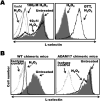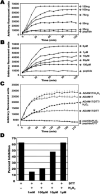Regulation of mature ADAM17 by redox agents for L-selectin shedding
- PMID: 19201900
- PMCID: PMC2653275
- DOI: 10.4049/jimmunol.0802770
Regulation of mature ADAM17 by redox agents for L-selectin shedding
Abstract
L-selectin is constitutively expressed by neutrophils and plays a key role in directing these cells to sites of inflammation. Upon neutrophil activation, L-selectin is rapidly and efficiently down-regulated from the cell surface by ectodomain shedding. We have directly shown that A disintegrin and metalloprotease 17 (ADAM17) is a primary and nonredundant sheddase of L-selection by activated neutrophils in vivo. Following cell activation, intracellular signals lead to the induction of ADAM17's enzymatic activity; however, the target of this inducer mechanism remains unclear. Our study provides evidence of an activation mechanism that involves the extracellular region of the mature form of cell surface ADAM17 and not its intracellular region. We demonstrate that the catalytic activity of purified ADAM17 lacking a prodomain and its intracellular region is diminished under mild reducing conditions by DTT and enhanced by H(2)O(2) oxidation. Moreover, H(2)O(2) reversed ADAM17 inhibition by DTT. The treatment of neutrophils with H(2)O(2) also induced L-selectin shedding in an ADAM17-dependent manner. These findings suggest that thiol-disulfide conversion occurring in the extracellular region of ADAM17 may be involved in its activation. An analysis of ADAM17 revealed that within its disintegrin/cysteine-rich region are two highly conserved, vicinal cysteine sulfhydryl motifs (cysteine-X-X-cysteine), which are well-characterized targets for thiol-disulfide exchange in various other proteins. Using a cell-based ADAM17 reconstitution assay, we demonstrate that the cysteine-X-X-cysteine motifs are critical for L-selectin cleavage. Taken together, our findings suggest that reduction-oxidation modifications of cysteinyl sulfhydryl groups in mature ADAM17 may serve as a mechanism for regulating the shedding of L-selectin following neutrophil stimulation.
Figures





Similar articles
-
Ectodomain Shedding by ADAM17: Its Role in Neutrophil Recruitment and the Impairment of This Process during Sepsis.Front Cell Infect Microbiol. 2017 Apr 25;7:138. doi: 10.3389/fcimb.2017.00138. eCollection 2017. Front Cell Infect Microbiol. 2017. PMID: 28487846 Free PMC article. Review.
-
ADAM17 deficiency by mature neutrophils has differential effects on L-selectin shedding.Blood. 2006 Oct 1;108(7):2275-9. doi: 10.1182/blood-2006-02-005827. Epub 2006 May 30. Blood. 2006. PMID: 16735599 Free PMC article.
-
ADAM17 activity and other mechanisms of soluble L-selectin production during death receptor-induced leukocyte apoptosis.J Immunol. 2010 Apr 15;184(8):4447-54. doi: 10.4049/jimmunol.0902925. Epub 2010 Mar 10. J Immunol. 2010. PMID: 20220092 Free PMC article.
-
Neutrophil adhesion to E-selectin under shear promotes the redistribution and co-clustering of ADAM17 and its proteolytic substrate L-selectin.J Leukoc Biol. 2008 Jan;83(1):99-105. doi: 10.1189/jlb.0507304. Epub 2007 Oct 10. J Leukoc Biol. 2008. PMID: 17928459
-
L-selectin: mechanisms and physiological significance of ectodomain cleavage.J Cell Mol Med. 2005 Apr-Jun;9(2):255-66. doi: 10.1111/j.1582-4934.2005.tb00354.x. J Cell Mol Med. 2005. PMID: 15963248 Free PMC article. Review.
Cited by
-
An activated form of ADAM10 is tumor selective and regulates cancer stem-like cells and tumor growth.J Exp Med. 2016 Aug 22;213(9):1741-57. doi: 10.1084/jem.20151095. Epub 2016 Aug 8. J Exp Med. 2016. PMID: 27503072 Free PMC article.
-
Ectodomain Shedding by ADAM17: Its Role in Neutrophil Recruitment and the Impairment of This Process during Sepsis.Front Cell Infect Microbiol. 2017 Apr 25;7:138. doi: 10.3389/fcimb.2017.00138. eCollection 2017. Front Cell Infect Microbiol. 2017. PMID: 28487846 Free PMC article. Review.
-
Extracellular PDI in thrombosis and vascular injury.Thromb J. 2025 Jul 28;23(1):76. doi: 10.1186/s12959-025-00765-1. Thromb J. 2025. PMID: 40721812 Free PMC article. Review.
-
Implications of ADAM17 activation for hyperglycaemia, obesity and type 2 diabetes.Biosci Rep. 2021 May 28;41(5):BSR20210029. doi: 10.1042/BSR20210029. Biosci Rep. 2021. PMID: 33904577 Free PMC article. Review.
-
A structural model of the iRhom-ADAM17 sheddase complex reveals functional insights into its trafficking and activity.Cell Mol Life Sci. 2023 Apr 29;80(5):135. doi: 10.1007/s00018-023-04783-y. Cell Mol Life Sci. 2023. PMID: 37119365 Free PMC article.
References
Publication types
MeSH terms
Substances
Grants and funding
LinkOut - more resources
Full Text Sources
Other Literature Sources
Molecular Biology Databases
Miscellaneous

